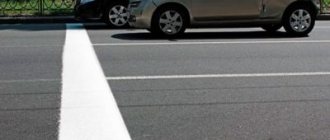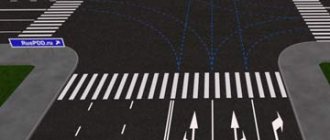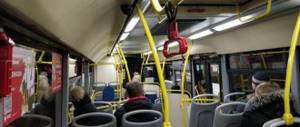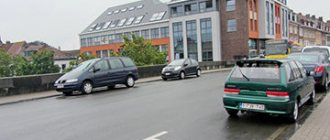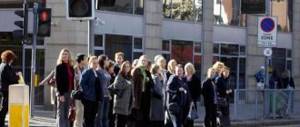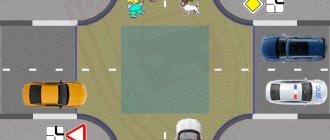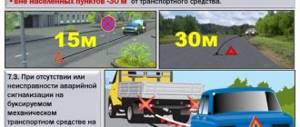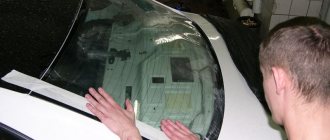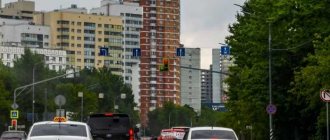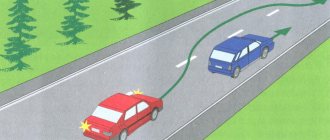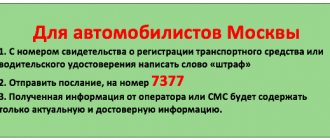Sign 6.16 Stop line
This sign belongs to the information category.
They notify about special requirements for driving modes on the road.
The presence of the sign forces the motorist to stop. The technical device in question looks like a rectangular sign with the word “Stop” on a white field.
The sign is installed most often in two cases:
- at unregulated crossings across railways;
- at intersections regulated by a working traffic light or traffic controller.
A different approach to placing plate 6.16 is also allowed:
- to the right of the highway;
- over the strip.
Often the sign is placed on the same support as the traffic light object.
A prohibitory signal from a traffic light or from a traffic controller, which is quite rare on modern roads, obliges the motorist to stop in front of the information technology device in question.
When a traffic light breaks down, the intersection becomes unregulated.
It is allowed to use the sign to repeat the corresponding marking, then it is placed on the same straight line with the marking line. Thus, traffic rules determine the priority value of markings.
Signalized intersections
13.4. When turning left or making a U-turn at a green traffic light, the driver of a trackless vehicle must give way to vehicles moving straight or to the right from the opposite direction. Tram drivers should follow the same rule among themselves.
13.5. When driving in the direction of the arrow turned on in the additional section simultaneously with a yellow or red traffic light, the driver is obliged to give way to vehicles moving from other directions.
13.6. If traffic lights or traffic controller signals allow the movement of a tram and trackless vehicles at the same time, then the tram has priority regardless of the direction of its movement. However, when moving in the direction of the arrow turned on in the additional section simultaneously with a red or yellow traffic light, the tram must give way to vehicles moving from other directions.
13.7. A driver who enters an intersection when the traffic light signal permits must drive in the intended direction regardless of the traffic light signal at the exit from the intersection. However, if at the intersection in front of the traffic lights located on the driver’s route there are stop lines, the driver must follow the signals of each traffic light.
13.8. When the traffic light turns on, the driver is obliged to give way to vehicles completing their movement through the intersection, and to pedestrians who have not completed crossing the roadway in this direction.
Why is a stop line needed?
It is proposed to analyze the need for a stop line.
A sign of this kind serves as a signal to motorists about the need to stop so that pedestrians can safely cross the road at a pedestrian crossing marked with special markings.
A stop line allows a motorist who has stopped in advance before an intersection to avoid an accident, since it prevents a collision with a car crossing his path.
Finally, the presence of this sign makes it easier for cars to maneuver at the intersection. It is known that vehicles have different dimensions.
Drivers of vehicles, all other things being equal, have different experience and skills. What is easy for one person may be difficult for another person.
The stop line reduces the likelihood of a car collision when making turns or other maneuvers permitted at a particular intersection.
It is worth emphasizing that the stop line, designed to ensure the safety of people on the roads, can be indicated both in tabular form and in the form of markings.
What does the stop line mean - read the traffic rules
First, let's figure out what the stop line is for. Firstly, its presence signals to drivers the need to stop to let pedestrians cross the road along the so-called zebra crossing. Secondly, this marking occurs at intersections provided with traffic lights. There it is needed in order to protect a driver stopped at a red light from a possible collision with a car moving along a perpendicular road.
A stop line at an intersection is also needed to ensure that vehicles do not interfere with each other when performing any maneuver according to traffic regulations, for example, a U-turn. For an experienced driver, a U-turn will seem like a trifle, but a beginner may not “fit” into the dimensions of the intersection and, when maneuvering, may go beyond its boundaries. If cars on a perpendicular road are parked too close to the border of the intersection, driving beyond the stop line, the chances of an accident will rapidly increase.
It is worth noting that a stop line can be either a marking or a road sign . Don't confuse them. If there is a “Stop” sign at the intersection, the driver must stop the car near the sign in two cases: when the red light is on or the traffic controller gives a prohibitory signal. The same situation applies to the corresponding markup. But the combination of the line and the “STOP” sign on a red background obliges the driver to stop in any case. It hardly needs to be said that ignoring such important signs can cost you not only and not so much the drawing up of a protocol, but your health and even your life.
Stopping before the “Stop line” marking
According to Decree No. 1090 of October 23, 1993, horizontal markings, which also include lines drawn directly on the road, regulate the order and modes of traffic or provide other information necessary for road users.
Stop line 1.12 indicates the place where the motorist must stop:
- at a prohibitory traffic light;
- in the event of a traffic ban issued by a traffic controller;
- if there is a sign 2.5.
Road markings
I would like to emphasize that not only the red, but also the yellow signal of a traffic light object is prohibitive.
Amount of the fine - what will the violation cost?
The fine for a stop line in 2013–2014 is quite a significant amount - around 800 rubles. But its size varies depending on the situation. Thus, a fine for driving through a stop line, driving through it and driving beyond the stop line at a red traffic light, or for a prohibitory gesture by a traffic controller standing on the road, will cost the violator all of 800 rubles.
But if you crossed the stop line at an uncontrolled intersection (which is important!), then the fine will be 500 rubles. Be extremely careful: near the stop line or instead of it there may be a road sign 2.5 “Driving without stopping is prohibited”, we have already talked about it above. You must stop near it and then continue moving.
Stopping at a stop line sign
The motorist must clearly understand where he should stop.
If there is a marking, you need to stop in front of it. Usually the line is located 3-5 meters before the traffic light.
If there is no horizontal line, the driver must act in accordance with the sign and take a break from driving immediately in front of it.
When using the sign and markings simultaneously, the stop is made in front of these signs. This situation does not cause difficulties when the sign and markings are placed on the same line, that is, they are installed in full accordance with the requirements of regulatory documents on standardization.
All this matters in relation to controlled intersections, that is, those where traffic is regulated:
- traffic light;
- traffic controller.
Neglecting the stop line is dangerous not only and not so much in financial losses, but in possible damage to health and even life.
Objectives and notation
According to current traffic regulations, this sign is used in two cases:
- at a pedestrian zebra crossing - it reminds drivers to stop and let people cross the road;
- at an intersection equipped with a traffic light - it indicates a place where a stationary vehicle will not create an emergency situation for cars moving perpendicularly.
A pointer can be designated in several ways:
- A white stripe on the asphalt.
- Prohibitory "Stop" sign.
- A combination of the two previous methods.
If there is a stop line sign or strip marking on the road, the driver must stop only if he sees a red light at a traffic light or a prohibitory signal from a traffic police officer regulating traffic.
When a sign and a line are used together, you must always stop moving. Crossing the stop line without stopping in this case is a traffic violation, and the violator may be subject to a fine.
A stop line on the asphalt indicates stopping at a red traffic light.
Controversial situation with the stop line
In practice, things do not always work out as well as declared by the current documents. So, let's look at how to stop correctly in front of a stop line sign.
Thus, the information technical tool 6.16 “Stop Line” cannot conflict with the marking of the same name 1.12. On real-life roads, unfortunately, a similar contradiction occurs. Where should the driver stop then? There is an answer to this question in the traffic rules and in already established judicial practice.
Appendix 2 of the Rules states that if there are discrepancies between road signs, including temporary ones, and horizontal marking lines, or if the markings are insufficiently visible, persons driving a car should be guided primarily by the road signs. These contradictory circumstances themselves are not specified.
The car stopped before the stop line
It is logical to assume that the “Stop Line” technical device, like other signs, has an advantage over marking lines, and therefore the car owner is obliged to stop driving in front of it.
However, real life is much broader than those nuances that can be outlined by law.
In practice, having passed the marking line and stopped in front of the sign of the same name, the motorist will break the rules and will be called to account on the basis of administrative legislation. This can be confirmed by the court decision in case No. 33-35706 of October 20, 2014.
Also, a dispute between a motorist and a guardian of the law is often provoked by an erased stop line in the presence of a corresponding sign.
If the stop line is not actually visible, then two situations are possible:
- The car owner drove beyond the stop line when the traffic light signal was prohibiting.
- The driver crossed the stop line when the signal allowed, and then stopped in front of the intersection when the signal changed.
It is much easier to challenge the second situation.
If for some reason the markings are not visible, but the requirements for its placement with sign 6.16 are met, the driver is unlikely to be able to avoid punishment for an offense.
How to stop before the stop line in different situations
Not everything in this matter is as simple as it seems at first glance, since in practice there are various options for combining a stop line with road signs, for example:
- In front of the intersection there are only road markings without additional road signs. In this situation, the stop line determines the place where the car needs to stop at a red traffic light or the corresponding gesture of the traffic controller.
- Before the intersection there are markings in combination with information sign 6.16 “STOP”, installed on the same line with the markings. Here, just as in the first case, the driver should stop in front of the stop line, but only if further movement is prohibited by a traffic controller or traffic light.
- The positions of the marking line and information sign 6.16 do not coincide, which is a violation of the requirements of the state standard for the installation of road signs. In such a situation, road signs take precedence over road markings, so the driver should stop in front of the road sign.
- The stop line is accompanied by a prohibitory sign 2.5 STOP, the position of which coincides or does not coincide with the location of the marking line. Then the driver is obliged to stop the car in front of the line.
- If an octagonal STOP sign is posted at an uncontrolled intersection, and the stop line is absent or invisible under snow cover and rain flow, then the car should be stopped before the border of the lane being crossed.
- If an octagonal STOP sign is placed at a railway crossing and there is no stop line, then the stop must be made in front of the road sign.
In all controversial issues about crossing the stop line and how to stop at it, stopping when the front wheels of the car do not reach the boundary of the marking line is considered correct. The bumper and other elements of the front of the car may cross the line.
